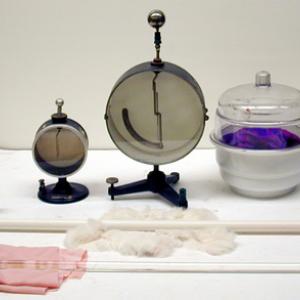College of Liberal Arts & Sciences
5A40.16 - Induction - Charging Electroscope by Induction
Rub the PVC rod with the cats fur. Bring the cats fur near the ball of the electroscope. Touch the ball of the electroscope with your finger. As you move the cats fur away the electroscope should remain charged. This charge should be opposite of the charge held by the PVC rod (negative).
Repeat the steps with the Plexiglas rod and silk.
- Richard S. Halada, "Electrons and Post-itTMtrons", TPT, Vol. 29, # 8, Nov. 1991, p. 543.
- Nobuo Naba, Oleg Jefimenko, "How Can an Electroscope be Charged This Way?", TPT, Vol. 17, # 1, Jan. 1979, p. 56.
- Zenon Gubanski, "Conversation of Charge", TPT, Vol. 8, # 5, May 1970, p. 269.
- Mario Iona, "Electroscopes Do Not Measure Charge", TPT, Vol. 8, # 8, Nov. 1970, p. 466.
- "Charging of an Electroscope", TPT, Vol. 3, # 4, April 1965, p. 185.
- "Charging an Electroscope by Induction", TPT, Vol. 3, # 1, Jan. 1965, p. 29.
- E-135: "Electroscope - Leaf & Electronic", DICK and RAE Physics Demo Notebook.
- Tik Liem, "The Induced Charge", Investigation to Science Inquiry, p. 245.
- Robert A. Morse, "Laboratory Activity 7: Two Plate Induction", Teaching about Electrostatics, p. 3 - 20.
- Janice VanCleave, "66, Fluttering Butterfly", Teaching the Fun of Physics, p. 102.
- "180, Inductive Charges?", Christopher P. Jargodzki and Franklin Potter, Mad About Physics, p. 69, 211.
- W. Bolton, "Induction of Charge", Book 4 - Electricity, Physics Experiments and Projects, 1968, p. 22-23.
Disclaimer: These demonstrations are provided only for illustrative use by persons affiliated with The University of Iowa and only under the direction of a trained instructor or physicist. The University of Iowa is not responsible for demonstrations performed by those using their own equipment or who choose to use this reference material for their own purpose. The demonstrations included here are within the public domain and can be found in materials contained in libraries, bookstores, and through electronic sources. Performing all or any portion of any of these demonstrations, with or without revisions not depicted here entails inherent risks. These risks include, without limitation, bodily injury (and possibly death), including risks to health that may be temporary or permanent and that may exacerbate a pre-existing medical condition; and property loss or damage. Anyone performing any part of these demonstrations, even with revisions, knowingly and voluntarily assumes all risks associated with them.
